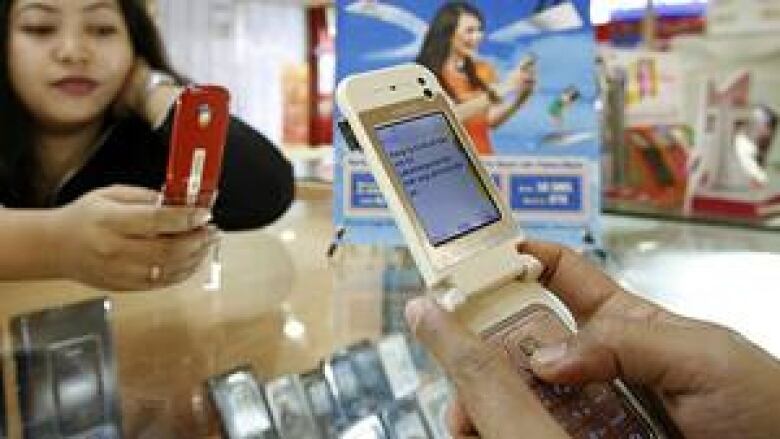Cellphone use may be linked to cancer: scientists

Using cellphones is considered a possible cause of malignant brain cancer, an international panel of scientists says.
"The WHO/International Agency for Research on Cancerhas classified radio frequency electromagnetic fields as possibly carcinogenic to humans, based on an increased risk for glioma, a malignant type of brain cancer, associated with wireless phone use," the group said in a statement Tuesday from Lyon, France.
"Given the potential consequences for public health of this classification and findings," said IARC director Christopher Wild, "it is important that additional research be conducted into the long-term, heavy use of mobile phones. Pending the availability of such information, it is important to take pragmatic measures to reduce exposure such as hands-free devices or texting."
The agency's working group of 31 scientists from 14 countries met this week to review hundreds of scientific papers on radiofrequency electromagnetic fields, including cellphones.
The cellphone reviewwas controversial for several reasons. It startedwith people who already had cancer and asked them to recall how often they used their cellphones more than a decade ago with older cellphone devices.
Cellphones produce non-ionizing radiation that can't damage DNA directly, so researchers don't know how it may affect the body an area the panel said still needs to be explored.
The agency is the cancer arm of the World Health Organization and the assessment now goes to WHO and national health agencies to consider guidelines forcellphone users.
The "possibly carcinogenic" category is used when there is inadequate evidence of cancer-causing effects in humans but there is sufficient evidence in animals.
Mary McBride of the BC Cancer Agency said she agreed with the classification, given that the science is not consistent.

In general, public health decisions are not made based on a classification of "possible carcinogen," McBride said, since the definition states that the evidence is limited and other explanations for the result are credible.
"Individuals on their own have a number of actions they can take to reduce exposure, notably reducing cellphone use, using hands-free devices, or texting rather than talking, based on their personal approach to the evidence and conclusions of the expert groups," McBride said in an email.
Industry groups for cellphone makers stressed thatthe"possibly carcinogenic" groupalso includes substances such as pickled vegetables and coffee.
The panel "did not state that there was a direct link to cancer," said Bernard Lord, president and CEO of the Canadian Wireless Telecomunnications Association, adding that the WHO has not changed any of its standards or recommendations.
"When you consider that more than half of 911 calls made in Canada are made from mobile devices, I think it's safe to say mobile devices have saved lives in Canada," Lord said.
Radiation factors
Placing voice calls on mobile devices rather than emailing or texting raises potential health concerns, because a user's level of exposure to radio-frequency energy is higher during a call. Talking on a handset takes a lot more power than sending and receiving texts or other information, and the handset is usually held closer to your body when you're speaking than when you're using the device for other purposes.
The amount of radiation in this case, electromagnetic waves emitted by handsets that penetrates your body is based largely on how close the device is to your head during calls, the number of phone calls you make, and how long your calls last.
The panel did not quantify the risk.A studypublished in 2010 showed asuggestion of increased risk for gliomas in the highest category of cellphone users, which was a reported average of 30 minutes per day over a 10-year period. The authors said biases and errors limited the strength ofconclusions fromthe Interphonestudy of almost 13,000 cellphone users.
Regulators such as Health Canada will consider the new findings, said Daniel Krewski, who is director of the R. Samuel McLaughlin Centre for Population Health Risk Assessmentat the University of Ottawa.
"The regulatory agencies worldwide will be looking carefully at the implications of the IARC determination for how they're going to advise people to deal with cellular telephones on a personal level," said Krewski. "This is a very significant determination on the part of the agency."
Health Canada's representative at IARC in Lyon,James McNamee, who is with the department's consumer and clinical radiation protection branch, called the evidence "credible", adding that it will requiremore research.
There's been little research on the effect of cellphone radiation exposure on children, but a large population study on childrenbeganlast year seeking to address the question.
In about 30 other studies done in Europe, New Zealand and the U.S., patients with brain tumours have not reported using their cellphones more often than unaffected people.
The panel also looked at workers' exposure to radiation from radar and microwaves, as well as environmental exposures from radio, TV and wireless telecommunication signals.
The new findings will be published as Volume 102 of the IARC Monographs, as well as the July 1 issue of the medical journal The Lancet Oncology, and in a few days online.
Nearly fivebillion people worldwide use cellphones, the panelestimated. About 78 per cent of Canadian households indicated they had a cellphone in 2010, according to Statistics Canada.
With files from CBC's Sachin Seth, Wendy Mesley and The Associated Press












_(720p).jpg)


 OFFICIAL HD MUSIC VIDEO.jpg)
.jpg)



























































































